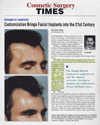Customization Brings Facial Implants into the 21st Century
Cosmetic Surgery Times – May, 1998
Beverly Hills facial plastic surgeon, Dr. William J. Binder is known worldwide for pioneering the use of alloplastic facial implants to enhance chins, cheeks and add facial volume to balance out facial structure and enhance youthfulness and beauty. The process is known as “facial contouring” and is now used by plastic surgeons across the globe. But Dr. Binder’s innovative spirit extends further and deeper than the anatomically accurate implants that he designed himself using CAD/CAM engineering software and 3-D computer modeling. Binder also made headlines in the early 1990’s for discovering that the wrinkle treating toxin Botox was also effective for treating migraine headaches which this past October (2010) was approved by the FDA for this purpose.
Dr. Binder, who is also an attending surgeon at Cedar Sinai Medical Center, Los Angeles, says the change allowed surgeons to augment not only the skeletal structure, but also to simulate the replacement of lost soft-tissue mass. He says computer-designed implants enable the surgeon to take the entire geographical area of the augmentation into consideration, rather than performing spot augmentation.
Dr. Binder says that today, the same technology has advanced so individual differences can be scanned, and customized implants can be made to solve specific anomalies.
He, along with Alan Kaye, MD, an oral maxillofacial surgeon at Cedar Sinai Medical Center designed the 3-D Accuscan system to create custom implants, allowing facial contour defects to be rebuilt with extreme accuracy. Now, Dr. Binder’s system also combines 3-D CT scanning with 3-D Accuscan technology to determine the exact measurements of needed implants. The base of the implant is so precise it fits the skeletal structure perfectly.
“The posterior surface of the implant conforms exactly to the surface of the bone so that in most cases it doesn’t even need a fixation technique; it just locks into place.”
Dr. Binder sees the use of the computer-designed implants expanding as technology continues to improve.
“I think what you’re eventually going to find – in about 5 to 7 years when the technology advances – will eventually be communicated via modem. It will be a very streamlined process to obtain a custom implant. It will be less labor intensive and will be much less costly because the computer will eventually be able to gauge the thickness of the skin and predict the amount of facial augmentation a particular implant design will create. The computer will design the implant to fit that particular patient and create the result you’re looking for in real life. That’s exciting.”

